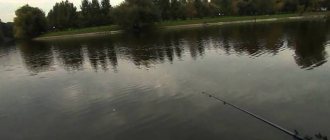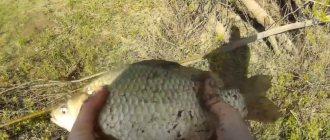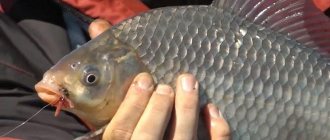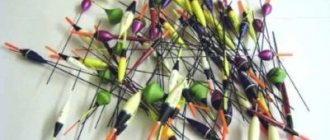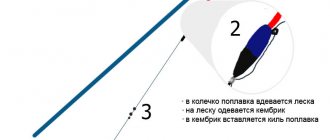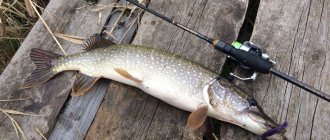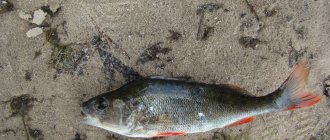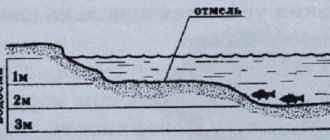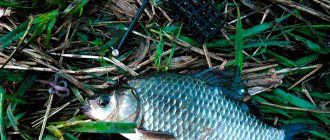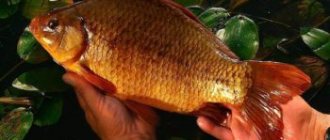Peculiarities of behavior of crucian carp in autumn
Crucian carp is a heat-loving fish, and after the end of the summer season its activity decreases significantly . As winter approaches, it goes deeper, so you shouldn’t count on even small crucian carp biting near the shore in the fall. That is why the easiest way to achieve success in crucian carp fishing in October is with feeder gear.
In the fall, the crucian carp prepares to hibernate until spring, but it continues to feed. The fish's appetite is noticeably reduced, but there is much less natural food in the reservoirs. Therefore, you can successfully catch crucian carp at this time if you know how to approach the fishing process.
When to catch crucian carp in October
Warm, cloudy days are best for catching crucian carp in mid-autumn . When choosing a time for fishing, you need to keep in mind that after sudden changes in the weather, the activity of crucian carp can decrease to almost zero.
On cloudy days, the fish begin to bite after 11 o'clock, when the morning coolness recedes. In clear weather, this fish goes out in search of food earlier - at 9-10 o'clock. As a rule, crucian carp feed in October no more than 4-5 hours a day .
Choosing a fishing spot
In small ponds and lakes, where crucian carp can be caught very well in summer, you cannot count on catches in October.
The water here cools quickly, and by mid-autumn the fish usually burrow into the mud until spring. For fishing, you should choose large lakes, rivers and reservoirs. Preference should be given to areas where there is a lot of aquatic vegetation. Here in October you can catch active crucian carp of any size, including trophy specimens. The best results can be achieved when fishing for crucian carp at depths of 3 to 5 meters . In such areas the water is warmer and the fish feel more comfortable. In October, crucian carp gather in large schools and move little around the reservoir. If you find a place where fish gather, you can count on an excellent catch.
Fishing for crucian carp with feeder tackle in autumn
Despite the fact that many fishermen are skeptical about catching crucian carp in the fall on a feeder, this fish can be successfully caught, even in October. Feeder fishing for crucian carp
one of the most successful ways to extract it. You can catch crucian carp with this tackle almost everywhere where it lives. And according to many experienced fishermen, it is much more effective than a float rod. Except for those cases when crucian carp begins to be caught in the water column in its uppermost horizons.
If we are talking about delicate bites of crucian carp, and as many fans of float fishing claim, the feeder does not record them, this is certainly not the case.
The soft tip of the feeder is able to react to the weakest pull of the crucian carp and, having recorded this, you can immediately hook it. But on the wave, such bites on the float are practically invisible. Therefore, we can conclude that in difficult fishing conditions, the feeder is much more sensitive than float tackle. Autumn fishing for crucian carp on a feeder
Especially at the beginning of the season, active crucian carp bite is observed almost everywhere. Moreover, over the last decade the number of crucian carp in the rivers has increased significantly; it has even managed to displace roach and other peaceful fish, which have always dominated there.
Today it often happens that a fisherman finds a good hole on the river and decides to catch bream there, and then large crucian carp begins to be caught there. It often happens that crucian carp displaces almost all representatives of other whitefish from such pits.
In the autumn season, in order to successfully catch crucian carp using feeder gear, you need to develop the right strategy, which we will try to analyze.
The first and very important question is where is it possible to successfully catch crucian carp on a feeder in the fall?
? There are many reservoirs that are considered carp fish, and there are no other types of peaceful fish there. In autumn, crucian carp always bite in such formations, and in this case the fisherman’s goal is to find deeper points. It is there that the crucian carp migrates to the first cold snap. In small ponds, crucian carp weighing no more than 150 g is usually caught. And in such “puddles” the feeder clearly has nothing to do. After all, most fishermen prefer to catch crucian carp weighing 200 grams or more.
Fishing cages
Information from other anglers about the specific bite on a particular body of water is very important. At the same time, the bite can be active in those places where crucian carp have never bitten before.
If there is no information about the autumn crucian carp biting in certain reservoirs, then you need to search for it yourself. You should remember or ask whether there was a good bite in these places in the spring. If there was and it started early, it means that the crucian carp should bite well in the fall.
There is such a sign that the earlier the active bite of crucian carp occurs in the spring and the more constant the weather is, the more massively the first spawning of this fish will occur. And the fewer pauses there are between the spawning of crucian carp, the better its bite will be by the end of summer and with the arrival of the autumn season. In some cases, successful fishing for crucian carp on a feeder in the fall
can continue almost until ice forms. However, this does not happen too often; the vagaries of nature are unpredictable. However, even if the situation is not developing very favorably, in any case there will still be a bite throughout the autumn season.
Successful feeder fishing for crucian carp in autumn
largely depends on the correctness of the chosen fishing location. Moreover, this dependence is much stronger than in summer, when crucian carp move more widely.
At the beginning of autumn, when it is still warm, crucian carp can be caught in shallow water as in the summer. But when the water gets colder and the algae begin to die off, crucian carp begin to move away from shallow coastal areas. And now there is nothing to do in such places early in the morning. At this time, crucian carp prefers greater depths, where the water is warmer.
It is assumed that in the autumn season the crucian carp gradually moves to the depths, often returning to shallow waters. In the first half of September, crucian carp are still kept in the zone of underwater vegetation. Usually, the depths increase beyond the grass border; these can be small holes or deep drops.
High-quality rods for catching peaceful and predatory fish
The holes beyond the vegetation boundary are usually silted; they are quite easy to find by test casting feeder gear. And if you use a watercraft, then finding suitable places is even easier. Usually the depth there is between 2-2.5 m.
At the beginning of October, the crucian carp moves to deeper depths from 3 to 5 m. The fish often goes into a deep-sea snag. Therefore, it is necessary to look for similar areas to which you can cast gear from the shore. As for fishing from a boat, in the autumn the wind often blows and, as a rule, it interferes quite significantly. There is a feeling that the bite is happening constantly because the tip of the rod is shaking all the time.
At such a time when crucian carp are shifting towards the depths, catching autumn crucian carp on a feeder with 2-3 gear is more promising. In this way, you can fish both distant and nearby areas. First of all, you need to find promising depths and then focus on fishing in them.
It is noteworthy that active biting of crucian carp can begin at the most unexpected moment, even on days when the weather is bad. Therefore, many fishermen go every day to the same body of water to “check” whether the active bite has begun. And if today and tomorrow the bite is weak, then the day after tomorrow the crucian carp may break through and the bite will be a feast for the eyes.
Catching crucian carp on a feeder in autumn
has its own laws. For example, if a south or southwest wind blows for several days in a row, then a significant number of crucian carp can concentrate near the surf shore, even in shallow water in October.
Wide selection of feeder feeders in our online store
At this time, there are excellent prospects for catching large crucian carp. And for fishing in the surf, fishing with a feeder is the best option. But, unfortunately, warm winds do not blow every autumn, and if you find yourself in warm surf, then you are very lucky.
Warm autumn rains also promise good prospects for crucian carp fishing. However, there are some subtleties here. When there is warm autumn rain, crucian carp are often caught not from the very bottom, and bites mainly occur in the water floor. In this case, you need to either change the equipment to a pop-up leash, or switch to fishing with a float tackle.
Sometimes active biting of crucian carp occurs during a period of strong cold, but short-term rain, or during the period when the first snowfalls occur. However, such moments last no more than one or two days. The weather often changes at this time, cold weather can set in suddenly, and the crucian carp will begin to act up.
You can find high-quality fishing lines and cords here
When does autumn fishing for crucian carp with a feeder
, but the bream or roach is starting to catch well. the crucian bite disappears. Large crucian carp will be caught during the day in late autumn, when the weather is warm and stable.
Basically, crucian carp bite in the fall occurs before 10 am, less often before 11 am. In the evening, crucian carp bites occur 2 hours before sunset. It begins to peck even more actively at dusk, and it is at this time that the largest individuals peck. But at night during the autumn season, crucian carp bite quite rarely, so catching it in the dark is practically useless.
Happy fishing!
Tackle
For catching crucian carp in October, a feeder rod with a length of about 3.3-3.6 meters is well suited. His test must be selected based on the conditions in which you intend to fish. On average it is 60-80 g . Lighter feeders should be used for fishing at shallow depths near the shore, and heavier feeders should be used if fishing will take place in the current, and a massive feeder is needed that the water flow will not move along the bottom. The rod must be equipped with a spinning reel size 1500-3000.
If monofilament fishing line is used, a thin thread with a diameter of about 0.18 mm will do. In cold water, crucian carp does not offer active resistance, and the invisibility of the equipment is of great importance when catching passive fish. The leash can be made from monofilament with a diameter of 0.12-0.14 mm. Another option is to use fluorocarbon for its manufacture with a similar tensile strength, which is even less noticeable in water than monofilament.
Variations of feeder equipment
Classic feeder tackle consists of:
- Feeder rod - a special form with a length of 2.7 to 4-4.2 meters, equipped with a large number of guide rings and removable sensitive tips, which are both a bite alarm and perfectly display the moment when the feeder falls to the bottom.
- A reel mounted on a fishing rod with a thin line wound around it - for feeder fishing, high-speed match inertia-free reels with shallow-depth metal spools and a reliable transmission mechanism are used.
- Metal mesh or spiral feeder
- One or more leashes with hooks tied to the main line or directly to the feeder.
DIY Gardner Loop
The Gardner loop is a classic feeder tackle. We do it point by point:
- On the main line released through the rings of the rod, a 50-60 cm piece of line is measured.
- At the very beginning, fold the fishing line in half to make a loop about 10 cm long.
- A swivel with a clasp is inserted into the loop and secured.
- The feeder is attached to the clasp.
- At the end of the fishing line, make another small loop, 2-3 cm long, to which the leash is tied with a loop-to-loop knot.
- The length of the piece of fishing line from the feeder attachment (from the loop assembly) to the leash loop should be 2-3 cm longer than the length of the loop and the feeder attached to it.
Paternoster equipment
The difference between the paternoster is that during installation two diameters of fishing line are used: the main one and a thinner one for attaching the feeder.
- A 40 cm segment is measured on the main fishing line, parallel to which a pre-cut piece of thinner (0.04-0.05 mm) fishing line is applied.
- Two pieces are tied in a double figure eight 40 cm from the end of the main one - you get two parallel pieces of fishing line.
- The secondary fishing line is shortened to 20 cm, a loop is made at its end, a swivel with a clasp is secured in it, and a feeder is attached to the clasp.
- At the end of the main fishing line, a loop is also made into which the leash is secured using a loop-to-loop knot.
Although this type of equipment is similar in design to the “Gardner loop”, due to the fastening of the feeder on a thinner line, it can be more effectively used for fishing in places with a heavily cluttered bottom - when fishing for crucian carp, even if the feeder gets caught on bottom debris, it due to the thinner section of the fishing line securing it, it will come off with little effort, thereby preserving the fish.
Equipment with an asymmetrical loop
The equipment was invented more than 20 years ago by Dutch fishermen and was used by them when catching bream and barbel on fast-flowing rivers.
DIY installation
- The equipment is tied on a meter-long piece of strong fluorocarbon fishing line with a cross-section of 0.28-0.3 mm.
- The segment is folded in half and a small loop is made, secured with a figure eight knot.
- The fishing line on both sides of the loop is folded parallel and a twist is made consisting of two twisted threads. The length of such a “braid” should be at least 10-15 cm.
- The place where the twist ends is fixed with a double knot.
- A swivel with a clasp is placed on one end.
- Bring the swivel to the knot that fixes the twist, move 2-3 cm away from it and fix this distance with your fingers
- The end on which the swivel was placed is applied to the second end, while holding the swivel with the clasp at a specified distance from the locking unit.
- A loop is made from the two ends, the excess ends are cut off.
- The feeder is attached to the clasp.
- A leash is attached to the twist ring using the “loop-to-loop” method.
Such a homemade installation allows, with the feeder lying motionless on the bottom, the leash with the nozzle to move in the water column, under the influence of the current or when a crucian bites.
Symmetrical loop
It is easier to make than the asymmetrical one and is not inferior to it in terms of catchability. Assembling the correct equipment is extremely easy:
- A swivel with a fastener is placed on a piece of fluorocarbon fishing line 1 meter long and with a cross-section of 0.3 mm and the feeder is fastened to it.
- The feeder is placed exactly in the center of the piece of fishing line.
- The fishing line is folded in half; in the place where the two ends meet, make a loop and tie it with a figure eight knot. The excess ends are cut off.
- A small loop is also made at the end opposite to the formed loop.
- A leash with a hook is attached to the resulting loop using a loop-to-loop knot.
Like the asymmetrical loop, symmetrical equipment allows the crucian carp, taking the bait with a hook, not to feel the weight of the feeder attached to the fishing line.
Equipment “Crucian carp killer”
The crucian carp killer allows you to catch crucian carp not only in the bottom layer, but also 20-30 cm above the bottom.
This equipment is assembled as follows:
- An elongated sinker weighing 20-25 grams is tied to a piece of dark braided cord with a cross-section of 0.12-0.14 mm and a length of about 60 cm.
- Next, a bead is put on the cord, pulled along it and fixed with a double loop at a distance of 5-6 cm from the sinker.
- Following the bead, a small feeder - a spring - is placed on the cord.
- The feeder is rested against the lower bead, then another bead is placed on top and fixed on the cord so that the spring is firmly fixed to it and does not have free movement along the cord.
- After the first spring is fixed, 10-15 cm are removed from it, and the second and third feeders are fixed in the same way.
- Short 3-4 cm leashes with hooks made of even thinner braided cord or fluorocarbon fishing line are attached to the wire spirals of the feeder using a loop-to-loop knot.
- This equipment ends with a swivel and a clasp, to which the main fishing line will be attached using a loop or winding ring.
Equipment with anti-twist
Equipment with an anti-twist allows you to avoid twisting of the line when casting, pulling out the equipment, or retrieving hooked fish.
Installation of this equipment is simple:
- A piece of fluorocarbon fishing line is passed through the hole inside the anti-twist, a stop silicone bead is put on each end and swivels are tied.
- A swivel with a clasp is attached to the carbine on the bend of the anti-twist, to which the feeder is attached.
- The fishing line is fixed with silicone stoppers so that the swivel adjacent to the long side of the anti-twist tightly rests against it, and the upper swivel has a certain distance between the fishing line and the stopper.
- The leash is tied to the lower swivel adjacent to the long arm of the anti-twist tube.
- The length of the leash should be such that when casting it does not cling to the feeder and the main line.
Feeder installations
To catch crucian carp in October, you should choose the most sensitive feeder equipment . Symmetrical and asymmetrical loops work well. If you have to fish on a heavily silted bottom, you should use a Gardner paternoster.
These rigs are tied quite simply, and at the same time they allow you to track the most careful touches of the fish to the bait. When fishing for crucian carp in cold autumn weather, these qualities are of particular importance. Good results can also be achieved by fishing with a rig with an anti-twist tube.
Lure
Bait for catching crucian carp in October should include a minimum of large particles . If they are present in large quantities, the fish, whose appetite is reduced in cold water, will quickly get enough of them. Therefore, when selecting ingredients for a bait mixture, it is worth focusing on small components that will attract fish, but will not allow it to satisfy its hunger.
Flavorings should be added to the bait in small quantities. A strong smell in cold autumn water may not attract, but rather scare away fish. Preference should be given to fishy rather than fruity aromas.
Selection of baits
, baits of animal origin work better . For autumn fishing for crucian carp they most often use:
- bloodworm;
- maggot;
- worm.
Many anglers consider the best bait for catching crucian carp in October to be a bunch of bloodworms. Good results can also be achieved by fishing with a bunch of worms. If there are no bites, you should try using a sandwich of bloodworms and maggots as bait.
Whenever you go fishing, you should have as many different baits with you as possible so that you can try them and choose the one that will bring the best catch on a particular body of water on a particular day.
Video
Catching crucian carp with a float rod video
Fishing for crucian carp in October video
Fishing with Palych. In mid-October, taking three fishing rods and worms with me, I went fishing to try to catch a good crucian carp in a familiar lake.
I arrived at about 10 o'clock, before lunch it was +5 C and sunny. Arriving at the place, I saw obvious traces of the activity of “networkers” - several visits to “nonsense”, because of this, the mood of course worsened. But there’s nothing to be done, I came fishing for autumn crucian carp, which means I have to try and try to catch it, preferably a larger one.
Features of fishing techniques
When fishing for crucian carp in October, you need to carefully watch the tip so as not to miss a single bite, and make timely hooks. Fish, which are rarely hungry in the fall, can quickly throw the bait out of their mouth, and most likely will have to wait a long time for the next bite.
Fishing for crucian carp in October does not cause much difficulty. Having quickly removed the hooked trophy from the feeding table, so as not to scare away its relatives, the fish can be slowly pumped out with a rod. Crucian carp, passive in cold water, offers almost no resistance, and taking it is not difficult.
With the right approach to fishing, the chances of remaining with a good catch in October will be maximum. But a lot also depends on simple luck - it is impossible to predict exactly on which days the crucian carp will bite well and on which days it will refuse to respond to the offered bait. All that remains to be done in such a situation is to prepare as best as possible for fishing, choose a suitable place on the reservoir, feed it and wait for bites in the hope that your efforts will be rewarded and the reservoir will present many excellent trophies.
Technique for catching crucian carp on a feeder
The preparatory stage includes creating a fisherman’s workplace and identifying a promising point in the reservoir. This is followed by collecting gear and preparing bait.
The feeding of complementary food from 10-15 feeders should be done exactly to the target. The animal component is not included in the mixture. After casting, wait 20-30 minutes. At this time, prepare a feeder with the addition of bloodworms or maggots.
After casting and sinking the sinker to the bottom, a slight sag of the fishing line is formed. The reel creates optimal tension and a slight bend in the tip of the blank. The feeder is placed on a prepared stand so that it is comfortable to stand, and when there is a bite, you can quickly hook it.
The wait for the first bite usually does not exceed 5-7 minutes. If there is no bite, the next cast is made with a change of food and bait.
The fish reveals itself by the trembling of the alarm. When winding the cord, it is necessary to keep it under tension, since the crucian carp, feeling the slack, gets rid of the hook. After landing, the catch is collected with a landing net.
If the fish does not show itself within an hour, it is reasonable to change the casting direction and the fishing location. The bait spot must be created anew.
